My modest attempt to demonstrate Canada’s contribution to the Battle of the Atlantic and the war at sea in general. In my honest opinion the most important thing we did as a nation besides the BCATP (British Commonwealth Air Training Plan). If the TIMEGHOST crew wants to use any of this information they are welcome to it. I enjoyed reading excerpts written about other countries that some of you have contributed, so I figured I’d do my own.
Sources:
“The Far Distant Ships” by Joseph Schull, ISBN-10 0773721606 (An official operational account published in 1950, somewhat sensationalist)
“North Atlantic Run” by Marc Milner, ISBN-10 0802025447 (Written in an attempt to give a more strategic view of Canada’s contribution than Joseph Schull’s work, published 1985)
“Reader’s Digest: The Canadians at War: Volumes 1 & 2” ISBN-10 0888501617 (A compilation of articles ranging from personal stories to overviews of Canadian involvement in a particular campaign. Contains excerpts from a number of more obscure Canadian books written after the war, published 1969)
SC-42, First Blood
What would eventually become known as the Battle of SC-42 is an important event for the RCN and the Battle of the Atlantic in general. It is a rather depressing example of the results of the untrained and poorly-equipped RCN going toe-to-toe with proper U-boat wolf packs operating at the best of their ability. It would openly show that the RCN was a long way from having the measure of the enemy. Although not the most costly convoy battle of the war, it was the first major convoy battle involving ‘significant’ RCN forces. Indeed, the escort itself was entirely Canadian when the battle began. I shall begin with a little bit of background.
As those of you who read my regular historical posts know, by September of 1941, the NEF had been fully established in St John’s, and a large chunk of the RCN was now operating under its flag. Convoys themselves were not organized in St John’s harbour. The escorts would rendezvous with convoys passing from the North American mainland (as the convoys were assembled and sailed from Halifax and Sydney) and escort them into the North Atlantic to a point south of Iceland, where the RN would take over. The RCN escorts would make a brief stop in Hvalfjordhur, Iceland, which had been made into a makeshift point of re-arming and refueling (very makeshift, tiny shore facilities and support ships did all the work). The ships would then sail back across the North Atlantic with a slow convoy on its own way back to North America. Deliver them safely and return to St. John’s for a brief respite before the whole cycle began again.
SC-42’s ocean escort group was group Twenty-Four. Its senior officer, Lieutenant-Commander J.C. Hibbard, RCN, in command of Skeena, had served in UK waters during the winter of 1940-41 as part of Clyde Escort Force and was therefore no stranger to convoy operations. Two of the group’s corvette, Orillia and Alberni, were original members of NEF, and had sailed with Skeena on at least one previous occasion. The newcomer to the newly formed Twenty-Fourth Group was the corvette Kenogami. She had commissioned at the end of May and had only just been assigned to NEF, replacing Primrose (RN) in Group Twenty-Four. Thus, aside from Kenogami, the escorts of SC-42’s screen were experienced (at least by 1941 standards) but hardly old salts when it came to dealing with a sustained pack attack.
Convoy SC-42 (Slow Convoy, Sydney, Cape Breton-Liverpool) departed Sydney on August 30th, 1941 with sixty-five ships assembled. The Convoy Commodore was Rear-Admiral W.B. Mackenzie aboard the merchant vessel Everleigh.
Group Twenty-Four met SC-42 just east of the Straits of Belle Isle at the end of the first week of September. Aside from bad weather, which plagued the convoy through most of its passage, reducing its speed to less than five knots, the first days were uneventful. As the convoy edged its way towards Cape Farewell, however, intelligence plotting of enemy movement indicated trouble ahead. The developing situation was watched closely in St John’s, not least by Prentice, who was making preparations for sailing with his first training group. In view of the threat to SC-42, Prentice obtained permission from Murray to sail with Chambly and Moose Jaw on Friday, 5th September (four days ahead of schedule). Prentice planned to join SC-42 just about the time it fell afoul of the U-boats, and shaped his course accordingly. On the second night out Prentice received a garbled transmission from CCNF which, in the light of verbal orders passed to him before he had left St John’s, he interpreted as an order to support the upcoming SC-43, due to pass the straits on the eleventh. Instead of retracing his path to meet SC-43 off Newfoundland, Prentice held his position due east of Cape Farewell and waited for SC-43 to close up. In the interim Chambly and Moose Jaw conducted exercises.

(A convoy forms up in the Bedford Basin, Halifax, Nova Scotia, circa 1941)
Meanwhile SC-42 forged along just south of Greenland. On 8th September, when the convoy was south-southeast of Cape Farewell, its course was altered to due north in hopes it would pass around the U-boat concentration which lay across its path. Such a course would eventually have carried SC-42 on to the rocky shores of Greenland. Since no ship had been able to take a sighting for over a week, Skeena went on ahead to watch for the coast. Course was held as long as possible, until at 19:00 Greenwich time, on the ninth the convoy altered to 43 degrees. SC-42 was still making only five knots in a moderate swell, with a sea state of five and strong winds out of the east-southeast. Three-quarters of an hour after SC-42 altered course towards Iceland, the moon, now four to five days after full, rose on the starboard. At about 21:37 Greenwich time, the first torpedoes struck home.
On the German side of things, we have some more information. The German U-boat group known as Gruppe Markgraf had been deployed to the south-west of Greenland on the 28th of August to patrol the convoy routes. Of course, said deployment had been uncovered by British Intelligence, and a number of other convoys were successfully re-routed around the searching submarines. (ON-10, ON-11, aforementioned SC-41, HX-146, and HX-147).
Failure to find any convoys necessitated redeployment, and as such, BdU subsequently dispersed the pack out over a wider area in the hopes of better results. This dispersal was also quickly made known to British Intelligence, but they did not know the exact positions of the U-boats. Furthermore, SC-42 was unable to make the same much larger and wider turns that the earlier convoys had made, and they were spotted by U-85 on the morning of September 9th. U-85 would make an unsuccessful (no hits) torpedo attack, and from that point forward would shadow the convoy while other U-boats changed course to intercept.
The torpedoes that hit home at 21:37 were fired by U-432, and struck the merchant vessel S.S. Muneric. Oblt. Heinz-Otto Schultze, commander of U-432, had fired four torpedoes at the convoy and believed he had scored two hits against two different ships. In actuality, both torpedoes had struck Muneric. Laden with iron ore, she sank immediately leaving no survivors. The port-side escort began to search the dark quarter of the convoy and was rewarded with an asdic contact. The latter turned out to be false, but Kenogami soon obtained a U-boat and engaged her target with the 4-inch gun. Firing the main armament without flashless powder, and unequipped with starshell, with which they might have illuminated their target. , Kenogami’s crew was left temporarily night-blind, and they soon lost the U-boat. In the meantime Skeena, coming down from her post directly ahead of the convoy, attempted to find the U-boat by firing starshell over the area in which she thought the attacker to be. Unfortunately the opportunity for a coordinated search never developed. Skeena no sooner reached the scene of Kenogami’s action that she was called away by the convoy commodore, whose lookouts had sighted a U-boat on his port bow. Aboard Skeena, Senior Officer Hibbard instructed Kenogami to search for ten minutes and then resume her position on the convoy’s port side, while Skeena set off to investigate the commodore’s report.
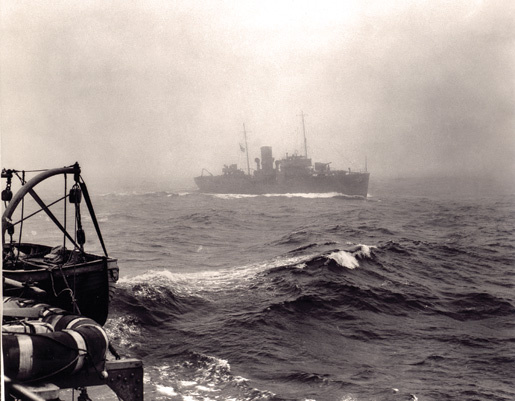
(HMCS Orillia in the fog, May 1941. Photo taken from the deck of HMCS Chambly.)
At 22:10 Greenwich time the leading ships in the fifth and sixth columns reported sighting a U-boat, whereupon the commodore ordered an emergency turn to starboard. No sooner was the turn underway than the lead ship of column six reported yet another U-boat on the surface directly ahead. In the interest of general safety the commodore then ordered a return to the original course. An hour and a half later (23:48) the ninth ship in the fifth column informed the commodore of a U-boat sighting off her starboard quarter. Skeena, in station just off the Commodore’s port bow, turned and passed down between the seventh and eighth columns to investigate the report. As she did so the commodore ordered an emergency turn to port, once again away from the general direction of the intruder. The turn caught Skeena in the midst of the convoy doing fair speed, and she had to manoeuvre wildly to avoid collision. As she did so, a U-boat passed up the convoy, also between the seventh and eighth columns. The German submarine drew fire from all nearby merchantmen and continued to do so as she passed by Skeena on a reciprocal course, so close were they that Skeena’s guns could not be depressed low enough to open fire.
Shortly after this haphazard confrontation, the U-boat dived, but the tangle of wakes from the advancing convoy prevented Skeena from relocating her adversary. While the destroyer was engaged in saving herself from the very ships she was charged with protecting, two ships in the fourth column, Baron Pentland and Tahchee, were stuck in rapid succession by U-652. Oblt. Georg-Werner Fraatz had fired two single torpedoes and three-minutes later heard two detonations. He would report two ships sunk. In reality both ships had suffered serious damage, but for the moment, remained afloat. Tahchee had been struck just ahead of the engine room and caught fire. The crew abandoned ship but would later reboard and extinguish the flames. Baron Pentland’s back was broken, and she was abandoned in short order. Ironically, her load of timber kept her from sinking, and U-372 would finish off the drifting wreck many days later. The commodore, now fearing further attacks on his port side, ordered yet another alteration of course, while the escorts, thrown off by the breadth and frequency of the sightings, and attacks, accomplished little.
Following this last flurry of activity, two quiet, suspense filled hours passed before the enemy would strike again. As the night of the 9th of September became the early morning of September 10th, astern of the convoy the real tragedy of such battles was acted out as men, numbed by cold and fear, struggled to save themselves and their ships. The corvette Orillia lingered astern to do what she could to help stricken vessels and survivors, while the last merchant ship in each column, designated the rescue ship, displayed an understandable reluctance to perform said task.
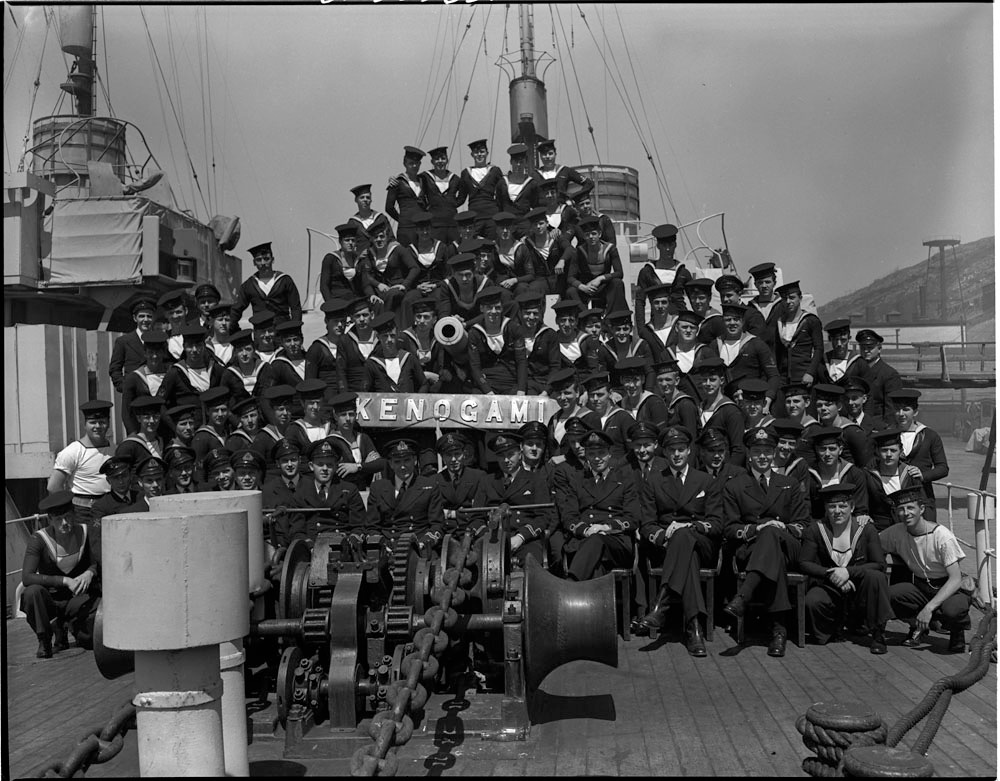
(Photograph of the crew of HMCS Kenogami, date unknown.)
At ten minutes past two the port side of SC-42 was hit twice. The first ship to be hit, Winterswijk, took two torpedoes, over an interval of several minutes, both on the port side. She went down in two minutes. Almost immediately Stargard was also hit on her exposed side. Both had been hit by U-432; she had fired three bow torpedoes and one stern torpedo. Stargard was hit amidships, near the engine room. The explosion annihilated the bridge deck and blew both port side lifeboats into the air. The ship began listing heavily to starboard and the entirety of the centre of the ship was enveloped in steam. Two men had been killed outright, and the captain and two other crewmen were thrown into the sea, though they were later picked up by one of the starboard lifeboats which had been successfully launched. Merchant vessel Regin went to Stargard’s aid, engaging the surfaced U-boat with her limited armament as she did. Skeena immediately left her position ahead and began to starshell over the port side of the convoy. With the help of Kenogami, Skeena searched for the attacker, gained some questionable contacts, and dropped a few depth charges, but to no avail. Meanwhile, astern, Orillia began to salvage the damaged tanker Tahchee, which effectively eliminated the escort from further action in defence of SC-42. The Orillia would eventually secure a tow-line and tow the stricken tanker to Iceland. Commanding officer William Briggs would be both praised and criticised for his actions, as he had essentially left the convoy without reporting it but would later be awarded the DSC (Distinguished Service Cross). With one escort essentially gone, and two others employed astern, only one was on station when the leading ship of the starboard column, Sally Maersk (more than five miles away from the rear) was struck on her outboard side by U-81. She would sink, but her entire complement of 34 men were all saved by Kenogami.
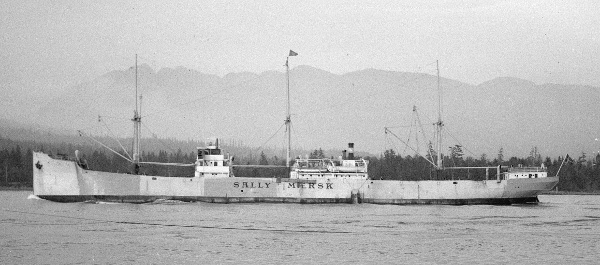
(S.S. Sally Maersk, date unknown, from the City of Vancouver Archives)
Moments later a U-boat was sighted by Thistleglen, and the commodore ordered another alteration of course to port. Alberni, the only escort left with SC-42, was ordered by Hibbard to investigate Thisteglen’s report, but the mass of turning merchantmen left Alberni little chance to act. Out of sheer frustration Alberni turned to rescue work, where at least she could accomplish something tangible.
For the time being SC-42 carried on without any escort at all, and it was not until 03:20 that Skeena, having left Kenogami to rescue survivors on the port side, resumed her position ahead of the convoy. Up to this point the U-boats had launched three successful attacks on the port side and one on the starboard side of SC-42. Although actual sightings of U-boats were plentiful, none of the enemy had been sighted by the escort in the act of closing on the convoy or launching an attack. Moments before the attack on SC-42 was renewed in the early hours of the tenth, Prentice’s training group, which had wandered southwestwards to rendezvous with SC-43, received orders to reinforce SC-42. En route Commander Prentice is recalled to have grinned at Lt. Edward T. Simmons, his first lieutenant.
“When we get there we’ll not have to worry about the convoy.” he said. “Our job will be to find the enemy and kill him.”
Since the exact whereabouts of the convoy was unknown, a rendezvous in the area of 64 degrees North, 32 degree 10’ West was worked out and course set accordingly. During the tenth Chambly and Moose Jaw intercepted further signals which allowed them to estimate the position of SC-42 more accurately. But it was not until well after dark on the second day of the battle that the tiny force was able to come to the Twenty-Fourth Group’s aid. In the interim, the battle continued unabated.
At 05:04 on the morning of the tenth the British CAM (Catapult Armed Merchant) ship Empire Hudson was torpedoed on her port side by U-82. Four of her crew were killed, the rest would be picked up by Baron Ramsay and Regin. This attack was followed shortly thereafter by an eleven-minute alteration of the convoy’s course to starboard. The main course was resumed at 05:12, while Skeena did an asdic search around Empire Hudson, now still in the water but buoyed by her cargo of grain. The search was only just under way when Skeena was again called away by a report of a periscope from the commodore’s ship. Nothing came of either search, nor of Alberni’s asdic contact on the starboard side an hour and forty minutes later. Kenogami, meanwhile, continued her work astern, which by now involved screening the intrepid freighter Regin as she went about her rescue work.
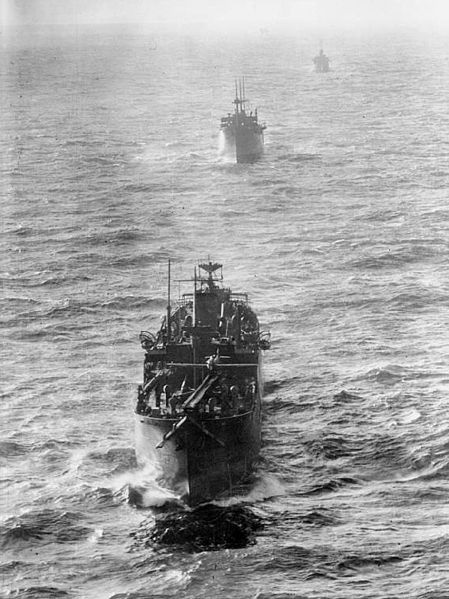
(From Wikimedia Commons, CAM ship Empire Spray, in convoy formation circa 1942. These ships were equipped with a single rocket-propelled catapult launching Hawker Hurricane, called a Hurricat or Catafigher. A single use contraption, the fighter could not be recovered and the pilot would bail out near the convoy.)
Attacks continued throughout the day on the tenth, and numerous periscopes were sighted by both the escort and the ships on the convoy. At 10:00 one such sighting resulted in another emergency turn, while Skeena conducted an unsuccessful asdic search and dropped random depth charges in an attempt to keep the U-boat at bay. Proper course was resumed at 10:30, but the alteration had served only to carry SC-42 to another waiting U-boat, and about an hour afterwards Thistleglen, ship of the vice-commodore, was stuck on her port side by U-85. Two successive emergency turns to port were ordered as Thistleglen, drawn down by the steel and pig iron in her holds, fell out of station and sank. Three crew went down with her, the remainder were saved by the Lorient. The escort, which had been in WACI day-escort screen number 3 (one ahead and one on each beam), joined in line of bearing and swept to the northwest of the convoy, but no U-boats were contacted.
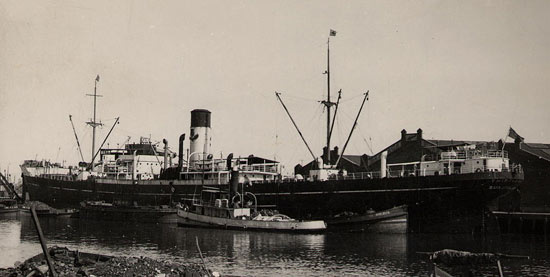
(S.S. Thistleglen, date unknown, photo from the Library of Contemporary History, Stuttgart.)
At the end of this sweep a periscope was reported by ships in the stern of the convoy. It was soon sighted by all three escorts, and Hibbard took Skeena in to deliver a depth-charge attack by eye. As the destroyer opened range to renew contact and attempt a more deliberate attack, Alberni dropped charges on an asdic contact only two thousand yards away. This threw off Skeena’s asdic recorder trace (which was essential for timing in a deliberate attack), and her attempt was delayed. When a firm contact was finally regained by both Skeena and Kenogami, the latter was instructed to act as directing ship while the destroyer delivered a ten-charge pattern. The attack produced a large air bubble and some oil. Unable to regain the contact following this apparently successful attack, Hibbard considered the U-boat sunk and ordered the corvettes to resume their stations screening the convoy. Skeena lingered briefly to ensure that the U-boat was well and truly down, if not actually destroyed.
Unbeknownst to Skeena, she had seriously damaged U-85, and the submarine was forced to retreat from the battle and return to France for repairs.
By early afternoon all the escorts were once again back on station (except Orillia who was still working with Tahchee). Nothing notable occurred until 18:05, when an aircraft from Iceland put in a brief appearance over the convoy. It dropped some flares on the port side of the convoy, indicating U-boat sightings, and a course alteration to starboard was ordered while the escort investigated. No U-boat contacts were obtained, and the main line of advance was resumed at 18:20. All remained quiet until at 20:57. Bulysse was hit on her port side. She exploded rather spectacularly. Skeena began a starshell search on the convoy’s starboard side, but in the deteriorated weather conditions, she was unable to locate anything untoward. While the convoy conducted an emergency alteration to starboard, the few survivors of Bulysse were picked up by Wisla, the last ship in the tenth column and the designated rescue ship. But no sooner was the new course assumed than the Gypsum Queen reported a U-boat on the surface off her starboard beam.
On hearing the news Skeena abandoned her search in the wake of SC-42 and turned to illuminate the starboard bow of the convoy. As she did this the Gypsum Queen was torpedoed and went down in under a minute. Both Bulysse and Gypsum Queen were sunk by U-82. 14 men were killed between them. Those who remained of her crew were picked up by Vestland, which also stood by her duty as rescue ship for the eighth column.
The pyrotechnics of the Bulysse were seen by the lookouts of Chambly and Moose Jaw. Throughout the 10th of September this small reinforcement had actually passed beyond SC-42’s line of advance with the intention of closing the convoy from the dark side after moonrise. This provided the two escorts with the best opportunity of catching lurking U-boats silhouetted against the southern sky. It was a tactic which paid off, albeit in slightly different form. U-boats were present on the dark side all right, and at half past midnight (now September 11th) Chambly’s asdic operator obtained a firm contact. The echo was confirmed as ‘sub’ by the ASW officer, but she was almost on top of it, only seven hundred yards distant, well inside the twelve hundred prescribed by current doctrine in depth-charge attacks.
"In view of the handiness and small turning circle of a corvette,’ Prentice wrote in his report, “it was decided to attack at once.” Chambly notified Moose Jaw she was moving in. Fifteen degrees of helm were ordered, and this soon brought the contact dead ahead. The echo was classified as ‘high’ (referring to the Doppler effect, the shift of pitch, between transmitted and received signals, that gives information on the speed of the target), and Prentice ordered a reduction in speed prior to attacking. Further classification of the target indicated that it was on a reciprocal course and therefore closing at a rate slightly faster than anticipated. For this reason and because the charges had already been set to a moderate depth, Prentice instructed that the five-charge pattern be laid a little early.
The order to fire was given at 00:38, just two minutes after the echo was first reported. But things did not go well on Chambly’s quarter-deck. The port thrower misfired, and the seaman at the port depth-charge rails missed his cue when the firing gong went (it was his first time on operations). As a result there was a slight delay in firing the first and second charges, and when they did go, they went rather close together. All five charges were heard to explode, and the first and second almost simultaneously. Upon completion of the attack Chambly swung round to port to regain the contact. But as she did U-501 surfaced close by Moose Jaw . Moose Jaw at first moved to ram, but upon seeing the German sailors massing on deck, broke off the attempt and instead drew alongside the U-boat, close enough for the submarine’s captain to step from his conning tower to the corvette’s forecastle without wetting his feet.
Fearing further boardings, Moose Jaw withdrew, giving the U-boat the opportunity to attempt to flee. As U-501 passed slowly across the corvette’s bows, Moose Jaw lurched forward and rammed her and then, with gunfire, prevented the Germans from manning their deck armament. As the U-boat’s crew began to fully assemble topside, Prentice put Chambly alongside and sent away a boarding party under Lieutenant Edward Simmons. After failing to persuade U-501’s crew at gunpoint to return below, simmons and his small partly gamely entered the submarine. Once inside they found the lighting system broken, instrumentation wrecked, and heard the tell-tale sound of rushing water. All save one of the boarding party were able to clear U-501 before she took her final plunge. Stoker W.I. Brown and eleven of the German crew perished. Simmons himself barely escaped.
Before she sank, U-501 had been found to be missing her rear port hydroplane and to have a large dent about thirty feet abaft of the conning tower. Survivors reported that the U-boat had been driven downwards by two explosions, which wrecked all the ship’s instrumentation, caused battery damage, and forced her to the surface. Prentice concluded that it was probably the poorly delivered first and second charges which had combined to do the damage. Thus skill and resolve on the bridge was enhanced by a healthy measure of luck. Once finished with U-501, Chambly and Moose Jaw took their places in the screen of SC-42. The Canadian Navy had sunk its first U-boat.
Note: After the war it was discovered that St. Laurent had come extremely close to sinking U-52 on August 4th, 1940, almost a year earlier.
It did nothing to deter further attacks. In the ensuing action around SC-42, five more ships were lost. Stonepool and Berury were both hit on the starboard side within minutes of each other (U-207 probably fired the spread that hit them, but it was never confirmed). Two hours later at 02:10, Scania and Empire Crossbill were struck almost simultaneously (probably on the port side and probably by U-82), followed at 02:30 by Garn, which was hit on her port side by U-432. Garn’s survivors were picked up by the Bestum. Empire Crossbill went down fast, Scania would be abandoned and left adrift for U-202 to finish off some time later.
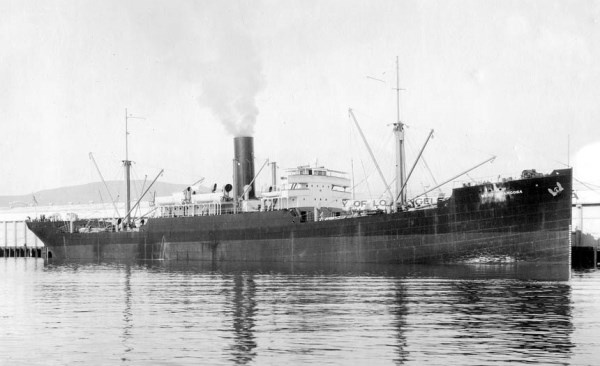
(Merchant vessel Empire Crossbill)
The loss of the last three of these ships could be largely attributed to the absence of Alberni, Kenogami, and Moose Jaw, all busy astern rescuing the crews of Stonepool and Berury, although Hibbard actually thought they were on station. Both Skeena and Chambly kept busy investigating asdic contacts and trying to prevent further losses. For all intents and purposes the battle ended in the forenoon of the 11th of September, when five destroyers from Escort Group Two arrived. Followed by three corvettes and two sloops (One RCN Corvette, all others RN) reinforced the escort, and the convoy moved within range of effective air support from Iceland. The Canadians would depart for Iceland, leaving the RN to finish the voyage. A few more attempts against the convoy would result in SC-42 losing only one more ship before making it to its destination, the Jedmoor, and two of the convoys reinforcement RN vessels (HMS Veteran and HMS Leamington) would sink U-207 on the last leg of the voyage, and the last U-boat (U-552) broke contact on the fourteenth.
The two nights during which NEF Group Twenty-Four fought alone were the acid test of the expansion fleet, and the fleet failed. The reasons for its failure have been touched upon, but it is necessary to illustrate just how these shortcomings manifested themselves in the face of the enemy. The remarkable achievement of Chambly and Moose Jaw tends to overshadow the tragedy of SC-42, and in fairness it was a positive accomplishment at a time when little seemed to be going right. But in no small way the sinking of U-501 was an aberration. It was natural for a young navy to forget its bloody nose and revel in the triumph of its first victory. It would be two more years before protecting the convoy would truly become more important than pursuing the enemy.
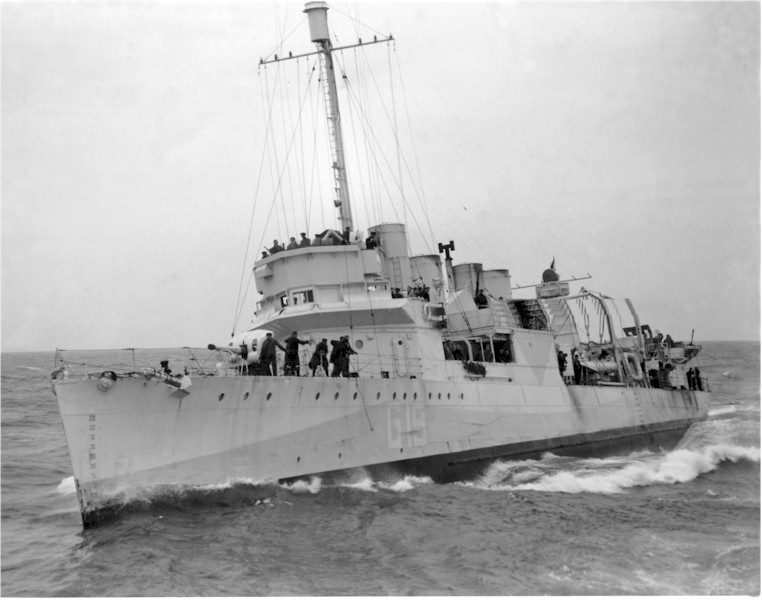
(HMS Leamington, a ‘four-stacker’ in RN service. She and Veteran took out U-207)
The final tally would be two U-boats sunk and one heavily damaged by the Allies. 52 German sailors killed and 11 taken prisoner.
The U-boats sent 16 merchant ships to the bottom (a few independents were sunk in the vicinity that I did not cover in my report), and heavily damaged 4 others. Including the independents, my best estimate based on the known losses shows that at least 276 merchant sailors were killed.
The reasons for the loss of sixteen ships from SC-42 and for the escort’s inability to deal effectively with the attackers were evident. As the Admiralty’s assessment of the SC-42 disaster concluded, the ‘slender escort’ of one destroyer and three corvettes was painfully inadequate to protect the full convoy from a pack of U-bots more than three times that number. It was widely recognized that Hibbard had made the best of a very difficult situation. Indeed, the surviving merchant captains ‘unanimously and spontaneously’ expressed their appreciation for the efforts of the Twenty-Fourth Group and, on their arrival in Britain, made that sentiment known to Admiral Noble at once. Immediately following SC-42 the British asked the RCN to increase the strength of NEF’s groups from the current four escorts to a minimum of six, two of which would now be destroyers. The Naval Council was quite prepared to accept this request, and the RCN could meet the increased commitment of smaller ships required (a minimum of forty-five corvettes based at St John’s). But the RCN simply did not have the fifteen destroyers needed to provide two (operational) with each of its six escort groups, nor were many of its Town-class capable of mid-ocean operations.